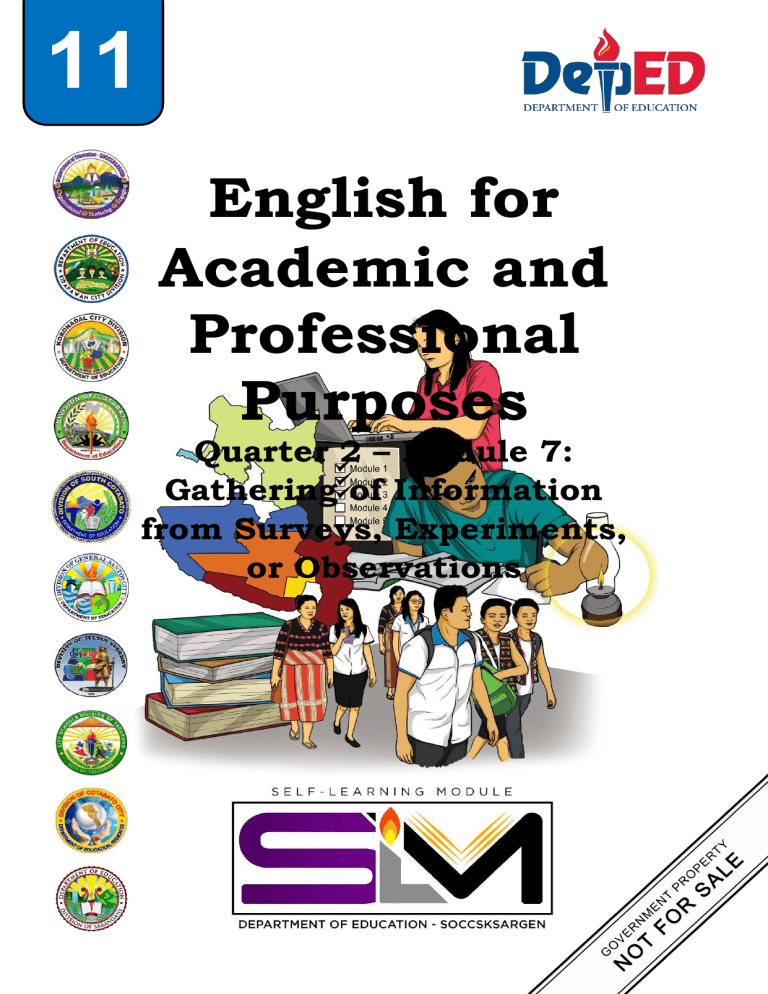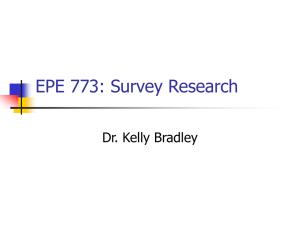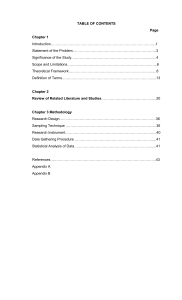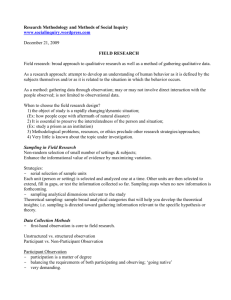
11 English for Academic and Professional Purposes Quarter 2 – Module 7: Gathering of Information from Surveys, Experiments, or Observations EAPP – Grade 11 Self-Learning Module (SLM) Quarter 2 – Module 7: Gathering of Information from Surveys, Experiments, or Observations First Edition, 2020 Republic Act 8293, section 176 states that: No copyright shall subsist in any work of the Government of the Philippines. However, prior approval of the government agency or office wherein the work is created shall be necessary for exploitation of such work for profit. Such agency or office may, among other things, impose as a condition the payment of royalties. Borrowed materials (i.e., songs, stories, poems, pictures, photos, brand names, trademarks, etc.) included in this module are owned by their respective copyright holders. Every effort has been exerted to locate and seek permission to use these materials from their respective copyright owners. The publisher and authors do not represent nor claim ownership over them. Development Team of the Module Writer: Jean M. Dizon Editors: Louie Mark Garvida, Imelda C. Martinez, Jerryl Jean L. Salunayan Reviewers: Helen J. Ranan, Sally A. Palomo Illustrator: Reggie D. Galindez Layout Artist: Cover Art Designer: Ian Caesar E. Frondoza Management Team: Allan G. Farnazo, CESO IV – Regional Director Fiel Y. Almendra, CESO V – Assistant Regional Director Romelito G. Flores, CESO V - Schools Division Superintendent Mario M. Bermudez, CESO VI – Assist. Schools Division Superintendent Gilbert B. Barrera – Chief, CLMD Arturo D. Tingson Jr. – REPS, LRMS Peter Van C. Ang-ug – REPS, ADM Gerardo Magno – Subject Area Supervisor Juliet F. Lastimosa - CID Chief Sally A. Palomo - Division EPS In- Charge of LRMS Gregorio O. Ruales - Division ADM Coordinator Ronnie R. Sunggay / Helen J. Ranan – Subject Area Supervisor / Coordinator Printed in the Philippines by Department of Education – SOCCSKSARGEN Region Office Address: Telefax: E-mail Address: Regional Center, Brgy. Carpenter Hill, City of Koronadal (083) 2288825/ (083) 2281893 region12@deped.gov.ph 11 English for Academic and Professional Purposes Quarter 2 – Module 7: Gathering Information from Surveys, Experiments, or Observations Introductory Message For the facilitator: Welcome to the English for Academic and Professional Purposes – Grade 11 SelfLearning Module (SLM) on Gathering Information from Surveys, Experiments, and Observation! This module was collaboratively designed, developed and reviewed by educators both from public and private institutions to assist you, the teacher or facilitator in helping the learners meet the standards set by the K to 12 Curriculum while overcoming their personal, social, and economic constraints in schooling. This learning resource hopes to engage the learners into guided and independent learning activities at their own pace and time. Furthermore, this also aims to help learners acquire the needed 21st century skills while taking into consideration their needs and circumstances. In addition to the material in the main text, you will also see this box in the body of the module: Notes to the Teacher This contains helpful tips or strategies that will help you in guiding the learners. As a facilitator you are expected to orient the learners on how to use this module. You also need to keep track of the learners' progress while allowing them to manage their own learning. Furthermore, you are expected to encourage and assist the learners as they do the tasks included in the module. 2 For the learner: Welcome to the English for Academic and Professional Purposes – Grade 11 SelfLearning Module (SLM) on Gathering Information from Surveys, Experiments, and Observation! The hand is one of the most symbolized part of the human body. It is often used to depict skill, action and purpose. Through our hands we may learn, create and accomplish. Hence, the hand in this learning resource signifies that you as a learner is capable and empowered to successfully achieve the relevant competencies and skills at your own pace and time. Your academic success lies in your own hands! This module was designed to provide you with fun and meaningful opportunities for guided and independent learning at your own pace and time. You will be enabled to process the contents of the learning resource while being an active learner. This module has the following parts and corresponding icons: What I Need to Know This will give you an idea of the skills or competencies you are expected to learn in the module. What I Know This part includes an activity that aims to check what you already know about the lesson to take. If you get all the answers correct (100%), you may decide to skip this module. What’s In This is a brief drill or review to help you link the current lesson with the previous one. What’s New In this portion, the new lesson will be introduced to you in various ways such as a story, a song, a poem, a problem opener, an activity or a situation. What is It This section provides a brief discussion of the lesson. This aims to help you discover and understand new concepts and skills. What’s More This comprises activities for independent practice to solidify your understanding and skills of the topic. You may check the answers to the exercises using the Answer Key at the end of the module. What I Have Learned This includes questions or blank sentence/paragraph to be filled in to process what you learned from the lesson. What I Can Do This section provides an activity which will help you transfer your new knowledge or skill into real life situations or concerns. 3 Assessment This is a task which aims to evaluate your level of mastery in achieving the learning competency. Additional Activities In this portion, another activity will be given to you to enrich your knowledge or skill of the lesson learned. This also tends retention of learned concepts. Answer Key This contains answers to all activities in the module. At the end of this module you will also find: References This is a list of all sources used in developing this module. The following are some reminders in using this module: 1. Use the module with care. Do not put unnecessary mark/s on any part of the module. Use a separate sheet of paper in answering the exercises. 2. Don’t forget to answer What I Know before moving on to the other activities included in the module. 3. Read the instruction carefully before doing each task. 4. Observe honesty and integrity in doing the tasks and checking your answers. 5. Finish the task at hand before proceeding to the next. 6. Return this module to your teacher/facilitator once you are through with it. If you encounter any difficulty in answering the tasks in this module, do not hesitate to consult your teacher or facilitator. Always bear in mind that you are not alone. We hope that through this material, you will experience meaningful learning and gain deep understanding of the relevant competencies. You can do it! 4 What I Need to Know This module is designed and written with you in mind. It is here to help you recognize the importance of gathering of information from survey, experiment, or observation. The scope of this module permits it to be used in many different learning situations. The language used recognizes the diverse vocabulary level of students. The lessons are arranged to follow the standard sequence of the course. In this module you will be able to: Gathers information from surveys, experiments, or observations Specifically, you are expected to: 1. determine the importance of gathering information 2. explain the processes in gathering information 3. identify the importance of gathering information in various field What I Know Before we proceed to our lessons and activities, let us answer the following questions to check first your prior knowledge about our topic. A. Multiple Choice A. TRUE OR FALSE Directions: Write True if the statement is correct; False if it is wrong. Write your answer on the space provided before each number 1. Survey is a technique which uses a questionnaire to gather information from the respondents. 2. Primary data are normally carried out from a survey. 3. Finding the research problem is the final steps in conducting an experiment. 4. Participants should be chosen based on her/his educational attainment 5. Identifying the objective is the primary step in conducting an observation 6. Telephone interview is a convenient way of conducting an experiment. 7. Sample represents the entire population. 8. Participants are the people who actually take part in the survey. 9. Defining variables is a process in conducting an observation. 10. Analyzing a result should be done after gathering of data. 5 Lesson 7 Gathering Information from Surveys, Experiments, or Observations In this lesson you will be taught on how to gather information from surveys, experiments or observation which is very important in conducting a research. The appropriate manner and tool that will support your studies is very essential in writing your paper. What’s In Fill in the diagram below with the steps to follow in conducting a survey. 6 What’s New How are you coping with our lesson? I hope you are curious and excited about the activities we will discuss and learn in this module. Activity 1: Student Survey: What Kind of Student are You? Directions: Answer the following questions honestly. 1. What do you like to be called? 2. What is your favorite subject? 3. Do you think school is hard, easy or both during this new normal? 4. Do you think you are a good student? 5. Do you have a difficult time in learning new things? 6. Are you a good test taker? 7. Do you feel comfortable asking help from your classmates? 8. Do you need much time in working your school assignments? 9. Do you like to work alone or with other? 10. What would you like me to know about you? What is It Now let us study the concept related to your activity. Gathering of information from Survey, Experiments or Observation Survey is defined as the act of examining a process or questioning a selected sample of individuals to obtain data about a service, product, or process. Data collection surveys collect information from a targeted group of people about their opinions, behaviour, or knowledge. An experiment is a data collection method where you as a researcher change some variables and observe their effect on other variables. The variables that you 7 manipulate are referred to as independent while the variables that change as a result of manipulation are dependent variables An observation is a data collection method, by which you gather knowledge of the researched phenomenon through making observations of the phenomena, as and when it occurs. You should aim to focus your observations on human behaviour, the use of the phenomenon and human interactions related to the phenomenon. Now let us learn how to gather information from survey, experiments or observation. Process in gathering information through survey: Step 1: Determine your objectives Each survey starts with a purpose or topic, which needs to be broken down into objectives. Our objectives should be clearly defined, as they inform our questions and data analysis. Make sure objectives are specific, measurable, and inform actions. Step 2: Define the population (Population and sampling) The group of individuals who are trying to research by conducting a survey is called the population. It will start of by generating a list of all population members, which we call a sampling frame. Respondents or participants are the people who actually take part in the survey. Step 3: Create a data analysis plan Before designing a survey, an analysis plan is needed. This will ensure what you think about everything needs to be analyzed, and how you can get statistical results that will let you make an analysis. The easiest way to create an analysis plan is to write out your survey objectives and how you plan to analyze each one. Step 4: Designing the survey After determining the objectives, population, sampling strategy, survey method, and analysis plan. These will all help with the next step: writing questions and designing our survey. Most surveys collect the following information: Demographics of respondents, including age, gender, income, and level of education, which can be used to describe the respondents and compare groups of respondents. Quantifiable information that can be analyzed statistically Open-ended question allow users to input their own answer and do not provide predefined response options. Example: What do you like best about your job? Closed-ended questions provide different types of response options from which respondents can choose an option. In contrast to open-ended questions, closed ended questions are easy to answer and allow us to conduct statistical analysis on the results. A closed-ended question include: o Multiple-choice questions. What is your favorite subject? □ Math □ Language □ Science□ History o Dichotomous questions: Provide with two (or three) options, such as “yes” and “no”. They can also contain a third option, such as “don’t know”. Do you like Korean dramas? ❍ Yes ❍ No 8 Rankings: Allow you to rank how important you think something is, compared to other options. Please rank the following in order of importance, from 1 to 4, where 1 is most important. Clean room☐ Lively room ☐ Quiet room with no distractions ☐ Fun room ☐ Rating scales: Allow you to indicate how strongly you agree with something or rate something. Indicate to what extend you agree with this statement: Having gadgets improves my interest in my studies ❍ Strongly disagree ❍ Disagree ❍ Neither agree nor disagree ❍ Agree ❍ Strongly Agree Step 5: Pre-testing It ensures the quality of responses that you look for problems, such as badlyphrased questions and missing response categories. First, we can do some tests by ourselves: Check different computers, tablets, phones and browsers to make sure everything works well. For example: Do rating scales work on a mobile phone? Check whether any contingency questions are skipping automatically. Be sure images, graphs, sounds, links and charts work and load. Look for style issues. Can you scroll down? Is the font easy to read? Second, assemble a small group of people who have not seen the survey before. Then let them take the survey, without offering any help or clarification if they have questions. Afterward, you can talk to them and look at their responses to see if there are any problem areas in our survey that need correcting. Finally, test the survey with a larger group of people and track how they do it. You want to measure the time it takes to complete questions and the entire survey, and you will be looking of which questions was skipped. Step 6: Conducting the survey There are different ways to distribute a survey: Send by email. Embed or advertise on a website or app, using a link. Using pop-up windows on a website or app. Posting on social media. These tools can help with most steps in the survey process, including the sampling frame, designing the survey, advertisement of the survey, and simple data analysis. It can improve response rates to our survey in several ways: Use an appealing invitation to (or advertisement of) the survey. Keep the survey short. Offer respondents something in exchange for filling out the survey, such as a discount on a product (but note that this impacts the sampling error). Follow-up invitations to remind people to fill out your survey. 9 Step 7: Data analysis Most survey tools include basic statistics and simple data analysis options. Researchers should also analyze the way respondents took the survey. Step 8: Reporting results The last step is to report survey results. Depending on the purpose of the survey, it might do things like: Write a report. Present the results in a meeting. Use the results as part of a larger research project. Ways of Interviewing Respondents Once you have selected your sample and developed your questionnaire, there are several ways you can interview participants: 1. In-person Interviewing When this method will be used, you meet with the respondents face to face and ask questions. This technique has excellent response rates and enables to conduct interviews that take a longer amount of time. It enable also to ask follow-up questions to responses that are not clear. On the other hand, this method is expensive and takes more time because of interviewer training, transport, and remuneration. 2. Telephone Interviewing Using this technique, the respondents can be called over the phone and will be interviewed. This method offers the advantage of quickly collecting data, especially when used with computer-assisted telephone interviewing and data collection via telephone is cheaper than in-person interviewing. This technique in gathering data has limitations; telephone interview had difficulty in establishing trust due to this reason, this may result to inaccurate responses or may introduce bias. Since phone interviews are generally kept short to reduce the possibility of upsetting respondents, this method may also limit the amount of data you can collect. 3. Online Interviewing This technique is used widely because it is a low-cost way of interviewing many respondents. Another benefit is anonymity; you can get sensitive responses that participants would not feel comfortable providing with in-person interviewing but the disadvantage of this technique is that you cannot seek clarification on responses that are unclear. 4. Mailed Questionnaire The printed questionnaires are sent to the postal address of the respondent. The participants fill in the questionnaire and mail it back. This interviewing method gives you the advantage of obtaining information that respondents may be unwilling to give when interviewing in person. The main limitation with mailed questionnaires is you are likely to get a low response rate. The inaccuracy of mailing address, delays or loss of mail could also affect the response rate. Additionally, mailed questionnaires cannot be used to interview respondents with low literacy, and you cannot seek clarifications on responses. 10 5. Focus Groups In using a focus group as a data collection method, identify a group of 6 to 10 people with similar characteristics. The responses are captured by video recording, voice recording or writing—this is the data you will analyze to answer your research questions. Focus groups have fewer resources and time as compared to interviewing individuals. Gathering Information through Observation Observation guides may be useful in documenting what is being observed. Various types of these guides may be developed, depending upon the purpose of the observation. They are particularly useful in situations where the researcher wishes to observe specific activities over a long period of time or in repeated observations. In an observational data collection method, it acquires data by observing any relationships that may be present in the phenomenon being studied. Four types of observational methods: 1. Cross-sectional method collects data on observed relationships once. This method has the advantage of being cheaper and taking less time as compared to case-control and cohort. However, cross-sectional studies can miss relationships that may arise over time. 2. Case-control method creates cases and controls and then observes them. A case has been exposed to a phenomenon of interest while a control has not. After identifying the cases and controls, it will move back in time to observe how the event of interest occurs in the two groups. 3. Cohort method follows people with similar characteristics over a period. This method is advantageous when you are collecting data on occurrences that happen over a long period. It has the disadvantage of being costly and requiring more time. It is also not suitable for occurrences that happen rarely. 4. Ecological method studies a population instead of individuals. Using ecological method saves time and money because data is already available. Gathering Information through Experiment An experiment is a data collection method where you as a researcher change some variables and observe their effect on other variables. The variables that you manipulate are referred to as independent while the variables that change as a result of manipulation are dependent variables. Designing a study Steps for designing a study: 1. Identify the variable (or variables) of interest and the population of the study. 2. Develop a detailed plan for collecting the data. When using a sample, you need to make sure that the sample is representative of the population. 3. Collect the data. 4. Describe the data using descriptive statistics. 5. Interpret the data and use inferential statistics to make decisions (or assumptions) about the population. 11 6. Identify any possible errors (some potential problems can be identified earlier in the process). Collecting Data This will focus on four methods for collecting data: Observational studies, experiments, simulations, and surveys. In an observational study, a researcher measures and observes the variables of interest without changing existing conditions. In an experiment, a researcher assigns a treatment and observes the response. Sometimes, a control group (a group receiving no treatment or a placebo) may be used to compare the effectiveness of a treatment. A simulation uses a mathematical, physical, or computer model to replicate the conditions of a process or situation. This is frequently used when the actual situation is too expensive, dangerous, or impractical to replicate in real life. A survey is used to investigate characteristics of a population. It is frequently used when the subjects are people, and questions are asked of them. When designing a survey, you must be very careful of wording (and sometimes ordering) the questions so that the results are not biased. Experimental Designs Definitions and Terminology A confounding variable occurs when an experimenter cannot tell the difference between the effects of different factors on a variable. The placebo effect occurs when a subject (or “experimental unit”) reacts favorably to a placebo when no medicated treatment has been given. Blinding is a technique used to make the subjects “blind” to which treatment (or placebo) they are being given. A double-blind experiment is one in which neither the experimenter nor the subjects know which treatment is being given. Randomization is a process of randomly assigning subjects to treatment groups. There are several different techniques for randomization: o A completely randomized design assigns subjects to different treatment groups through random assignment. o randomized block design is sometimes used to make sure that subjects with certain characteristics are assigned to each treatment. o Matched pairs design pairs up subjects according to similarities. One subject in the pair receives one treatment, while the other receives a different treatment. Sample size is the number of participants in the experiment. The larger the sample, the more representative of the population the results will be, but the costs of the experiment will also be higher. Replication is the ability to reproduce the experiment (and results) under similar conditions. 12 Sampling Techniques Definitions and Terminology A sampling error is the difference between the results of the sample and those of the population. A biased sample is one that is not representative of the entire population. Thus, it avoids biases. A random sample is one in which every member of the population has an equal chance of being chosen. A stratified sample is used when it is important to have members from multiple segments of the population. First, the population is split into segments (called “strata”), then a predetermined number of subjects is chosen from each of the strata. Cluster sampling can be used when the population naturally falls into subgroups with similar characteristics. First, determine the clusters, then select all the members of one or more of the clusters. Systematic sampling involves assigning a number to each member of the population and ordering them in some way. Sample members are selected by choosing the first member randomly, then selecting subsequent members at regular intervals after the starting number (for example, every 7th person). This method is fairly simple to use but should be avoided if there are regularly occurring patterns in the data. A convenience sample consists only of available members of the population, but this often leads to biased studies. A volunteer sample is a kind of convenience sample in which only volunteers participate. The greatest advantage of using an experiment is that you can explore causal relationships that an observational study cannot. Additionally, experimental research can be adapted to different fields like medical research, agriculture, sociology, and psychology. Nevertheless, experiments have the disadvantage of being expensive and requiring a lot of time. 13 What’s more You have already gained insight on how to gather information from surveys, experiments or observation. This time, let us do the activities and see how much you have learned. Activity 2: Answer Me! A.Directions: Identify the words being described by filling out the boxes. 1 A way to gather data by watching people, events or noting physical characteristics in their natural setting 2. A structured conversation where the participant asks questions and the other provides an 3. It provides insight into cause – and –effect by demonstrating what outcome occurs when a particular factor is manipulated. 4. It is the collection of information from a sample of individuals through their responses to questions. 5. It is an instrument consisiting of a series of questions for thr purpose of gathering information from the respondents. 14 B. Answer Me! Identify whether each of the following topics can be examined by observation or not. Write “ Yes” on the blank if it is observable and “ No” if it is not. 1. Plant growth 2. Students’ beliefs about joining fraternities 3. The opinion of the parents on face – to- face classes 4. The behavior of emeetings employess during meetings 5. Cooking procedures followed by experience chefs What I Have Learned Now let us sum up what you learned from our lesson by answering the questions below: 1. What are the steps in gathering information though survey? 2. How is the observational method of gathering information being conducted? 3. What are the advantages of experiments? 15 What I Can Do You have answered all the activities in this module and it’s time for you to apply what you have learned. Activity 3: Formulate a Survey Tool Directions: Make your own survey questionnaire consisting of questions related to the learning experiences you encountered during this new normal. Formulate at least 10 questions only. Choose your participants from your household to answer your survey questionnaires. (Follow the steps in conducting a survey) Please be guided by the criteria for scoring your outputs. Suggested Rubrics for Scoring: Mechanics………….………….............. 20pts. Organization.…….………..............…… 15pts. Creativity and presentation……….….. 15pts. Total………………………….............….. 50pts Assessment A. Multiple Choice Directions: Read each questions carefully. Choose the letter of the correct answer and write it on the space provided before each number. 1. Which of the following does not describe a good objective? a. measurable b. specific c. realistic d. smart 2. It is a process where researchers meet the participants face to face and ask relevant questions. a. panel interview b. virtual interview c. in- person interview d. group interview 16 3. It is a method of collecting data where the identified 6 to 10 people with similar characteristics are group together. a. focus group b. small group c. control group d. case group 4. These survey questions comprise two or three options. a. multiple- choice questions b. dichotomous questions c. open – ended questions d. close – ended questions 5. These are questions that allow users to input their own answer and do not provide predefined response options. a. close – ended questions b. open-ended questions c. multiple- choice questions d. rating scales 6. It is the observational method that follows people with similar characteristics over a period. a. ecological method b. cross-sectional method c. cohort method d. case- control method 7. It is a method that creates cases and controls and then observes it. A case has been exposed to a phenomenon of interest while a control has not. a. ecological method b. cross-sectional method c. cohort method d. Case-control method 8. It is a sampling technique which every member of the population has an equal chance of being chosen as participants. a. random sampling b. cluster sampling c. systematic sampling d. stratified sampling 9. It is a sampling technique that consists of available members of the population, but this often leads to biased studies. a. bias sampling b. convenience sampling c. cluster sampling d. volunteer sampling 10. It is the number of participants in an experiment. a. Sample size b. Population c. Participants d. Respondents 17 B. TRUE OR FALSE Directions: Write True if the statement is correct; False if it is wrong. Write your answer on the space provided before each number 1. Defining variables is a process in conducting an observation. 2. Analysing a result should be done after gathering of data. 3. Sample represents the entire population. 4. Finding the research problem is the final steps in conducting an experiment. 5. Primary data are normally carried out from a survey. Additional Activities Congratulations! You have come this far. I know you have learned a lot about gathering information from a surveys, experiments, or observation. Now, let us do this additional task. Activity 4: Imagine that you were tasked to revise the content of a questionnaire for a study titled “Impact of Posting Students’ Speeches on YouTube on their Speaking Performance.” Put a / before the indicator which should be included in the questionnaire and X before those which should be excluded. 1. Posting my speech on the YouTube boosts my self-confidence. 2. Posting mu speech on the YouTube facilities constructive feedback from my target audience. 3. Posting my speech on the YouTube helps me electronically collect, store, and manage clips of my spoken performance. 4. Posting my speech on the YouTube helps me develops my skills in speaking in formal events and occasions. 5. Posting my speech on the YouTube helps me evaluate and reflect on my speaking performance holistically. 6. Posting my speech on the YouTube helps me improve my skills in information and communications technology. 7. Posting my speech on the YouTube helps me improve my skills in utilizing video equipment and applications. 8. Posting my speech on the YouTube helps me improve my understanding of my abilities as a communicator. 9. Posting my speech on the YouTube helps me monitor my progress as a communicator 10. Posting my speech on the YouTube helps me recognize the gaps in my speaking skills at present. 18 Answer Key 19 References Book Sources Barrot, J. (2017) Practical Research for Senior High School Bueno, D. (2016). Practical Quantitative Research Writing for Senior High SchoolMegrito, L (2016) Applied Research: an Introduction to Quantitative Research Methods and Report Writing Otero, R. (2016). English for Academic and Professional Purposes Worktext Otero, R. (2016). Practical Research 1 Worktext Online Sources https://www.googgle.com/search questionnaire www. personal-development-zone.com https.//www. goggle .com/ gathers+ informations+experiments+survey questionpro.com/blog/survey-data-collection 20 DISCLAIMER This Self-learning Module (SLM) was developed by DepEd SOCCSKSARGEN with the primary objective of preparing for and addressing the new normal. Contents of this module were based on DepEd’s Most Essential Learning Competencies (MELC). This is a supplementary material to be used by all learners of Region XII in all public schools beginning SY 2020-2021. The process of LR development was observed in the production of this module. This is version 1.0. We highly encourage feedback, comments, and recommendations. For inquiries or feedback, please write or call: Department of Education – SOCCSKSARGEN Learning Resource Management System (LRMS) Regional Center, Brgy. Carpenter Hill, City of Koronadal Telefax No.: (083) 2288825/ (083) 2281893 Email Address: region12@deped.gov.ph 20







